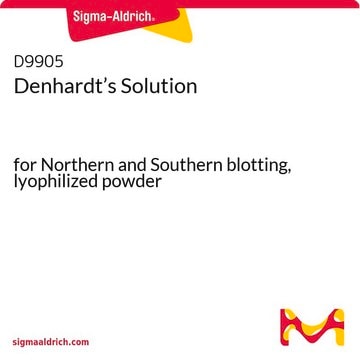GERPK0325
Microarray Hybridisation Buffer Version 2
Cytiva RPK0325, pack of 1 ea
Sign Into View Organizational & Contract Pricing
All Photos(1)
About This Item
UNSPSC Code:
41116006
NACRES:
NA.25
Recommended Products
packaging
pack of 1 ea
manufacturer/tradename
Cytiva RPK0325
shipped in
dry ice
storage temp.
−20°C
General description
DNA microarrays can be used to measure the expression levels of large numbers of genes simultaneously (gene expression profiling), or to genotype multiple areas of a genome (SNP arrays), with variable coverage or resolution depending how many DNA “spots” cover those areas.
A DNA microarray (or DNA chip) is a collection of microscopic DNA spots arranged in an array and attached to a solid surface, usually a microscope slide. Each DNA spot contains a specific DNA sequence, known as a probe, or hybridization probe. These can be short sections of a gene or other DNA elements and are often used to hybridize a cDNA sample (called the target) under high-stringency conditions. This is where it is useful to have a standardized, proprietary nucleic acid hybridization solution, to get as high as possible a signal to noise ratio for genes which are less highly expressed and allowing this expression to be semi-quantified.
Probe-target hybridization is usually detected and quantified by detection of fluorophore- or chemiluminescence-labeled targets to determine relative abundance of nucleic acid sequences in the target.
When looking at gene structure (e.g. copy number) the hybridization is with DNA rather than cDNA, and the technique is known as array CGH, which is used in looking at copy numbers of genes involved in different cancers, and in looking at genetic diseases.
A DNA microarray (or DNA chip) is a collection of microscopic DNA spots arranged in an array and attached to a solid surface, usually a microscope slide. Each DNA spot contains a specific DNA sequence, known as a probe, or hybridization probe. These can be short sections of a gene or other DNA elements and are often used to hybridize a cDNA sample (called the target) under high-stringency conditions. This is where it is useful to have a standardized, proprietary nucleic acid hybridization solution, to get as high as possible a signal to noise ratio for genes which are less highly expressed and allowing this expression to be semi-quantified.
Probe-target hybridization is usually detected and quantified by detection of fluorophore- or chemiluminescence-labeled targets to determine relative abundance of nucleic acid sequences in the target.
When looking at gene structure (e.g. copy number) the hybridization is with DNA rather than cDNA, and the technique is known as array CGH, which is used in looking at copy numbers of genes involved in different cancers, and in looking at genetic diseases.
Features and Benefits
- Includes a blend of proprietary components to provide highly reproducible, high-quality automated and manual DNA microarray hybridizations
- Hybridization rate enhancers improve the detection of rare targets
- Proprietary blocking agents minimize non-specific background
Storage and Stability
Please be aware this product may be shipped 90 days before the expiration date. For more information on the batch specific expiration date, please contact technical service.
Analysis Note
To view the Certificate of Analysis for this product, please visit www.cytiva.com.
Storage Class Code
12 - Non Combustible Liquids
Certificates of Analysis (COA)
Search for Certificates of Analysis (COA) by entering the products Lot/Batch Number. Lot and Batch Numbers can be found on a product’s label following the words ‘Lot’ or ‘Batch’.
Already Own This Product?
Find documentation for the products that you have recently purchased in the Document Library.
Our team of scientists has experience in all areas of research including Life Science, Material Science, Chemical Synthesis, Chromatography, Analytical and many others.
Contact Technical Service







